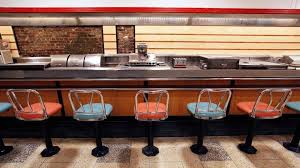
This Day 1960: Greensboro Lunch Counter Sit-In
The Greensboro Sit-In-- February 1, 1960: A civil rights protest that started in 1960, when young African-American students staged a sit-in at a segregated Woolworth’s lunch counter in Greensboro, North Carolina,and refused to leave after being denied service.
The sit-in movement soon spread to college towns throughout the South. Though many of the protesters were arrested for trespassing, disorderly conduct or disturbing the peace, their actions made an immediate and lasting impact, forcing Woolworth’s and other establishments to change their segregationist policies.
Greensboro Four
The Greensboro Four were four young black men who staged the first sit-in at Greensboro: Ezell Blair Jr., David Richmond, Franklin McCain and Joseph McNeil. All four were students from North Carolina Agricultural and Technical College.
They were influenced by the non-violent protest techniques practiced by Mohandas Gandhi, as well as the Freedom Rides organized by the Congress for Racial Equality (CORE) in 1947, in which interracial activists rode across the South in buses to test a recent Supreme Court decision banning segregation in interstate bus travel.
The Greensboro Four, as they became known, had also been spurred to action by the brutal murder in 1955 of a young black boy, Emmett Till, who had allegedly whistled at a white woman in a Mississippi store.
Did you know? The former Woolworth's in Greensboro now houses the International Civil Rights Center and Museum, which features a restored version of the lunch counter where the Greensboro Four sat. Part of the original counter is on display at the Smithsonian National Museum of American History in Washington, D.C.
Sit-In Begins
Blair, Richmond, McCain and McNeil planned their protest carefully, and enlisted the help of a local white businessman, Ralph Johns, to put their plan into action.
On February 1, 1960, the four students sat down at the lunch counter at the Woolworth’s in downtown Greensboro, where the official policy was to refuse service to anyone but whites. Denied service, the four young men refused to give up their seats.
Police arrived on the scene, but were unable to take action due to the lack of provocation. By that time, Johns had already alerted the local media, who had arrived in full force to cover the events on television. The Greensboro Four stayed put until the store closed, then returned the next day with more students from local colleges.
Sit-Ins Spread Nationwide
By February 5, some 300 students had joined the protest at Woolworth’s, paralyzing the lunch counter and other local businesses. Heavy television coverage of the Greensboro sit-ins sparked a sit-in movement that spread quickly to college towns throughout the South and into the North, as young blacks and whites joined in various forms of peaceful protest against segregation in libraries, beaches, hotels and other establishments.
By the end of March the movement had spread to 55 cities in 13 states. Though many were arrested for trespassing, disorderly conduct or disturbing the peace, national media coverage of the sit-ins brought increasing attention to the civil rights movement.
In response to the success of the sit-in movement, dining facilities across the South were being integrated by the summer of 1960. At the end of July, when many local college students were on summer vacation, the Greensboro Woolworth’s quietly integrated its lunch counter. Four black Woolworth’s employees—Geneva Tisdale, Susie Morrison, Anetha Jones and Charles Best—were the first to be served.
Read full article @ link below
Citation Information
Article Title
Greensboro Sit-In
Author
History.com Editors
Website Name
HISTORY
URL
https://www.history.com/topics/black-history/the-greensboro-sit-in
Access Date
February 1, 2020
Publisher
A&E Television Networks
Last Updated
June 7, 2019
Original Published Date
February 4, 2010
BY
HISTORY.COM EDITORS
Citation Information
Article Title
Greensboro Sit-In
Author
History.com Editors
Website Name
HISTORY
URL
https://www.history.com/topics/black-history/the-greensboro-sit-in
Access Date
February 1, 2020
Publisher
A&E Television Networks
Last Updated
June 7, 2019
Original Published Date
February 4, 2010
BY
HISTORY.COM EDITORS


 How to resolve AdBlock issue?
How to resolve AdBlock issue? 